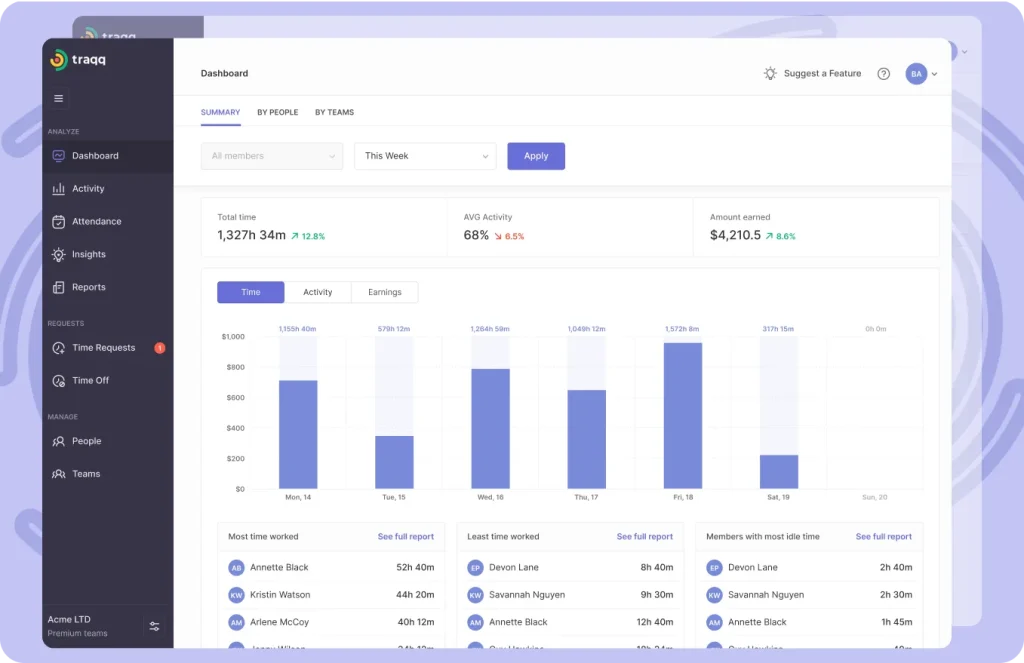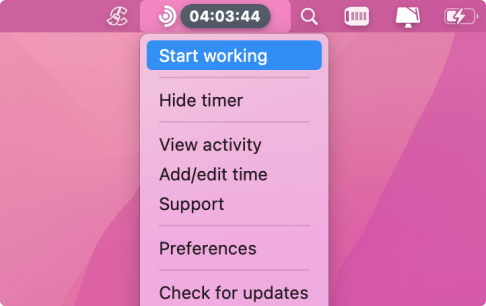Have you ever wrapped up a project and wondered if it actually moved the needle for your business, or if it just consumed valuable time and resources?
That’s the question I hear most often from business owners I work with. The reality is that every project you take on is an investment, and unless you’re measuring the return, you’re flying blind. This is where time-based ROI comes in. It’s not just about the money spent, it’s about the hours your team commits, how effectively those hours are used, and what they ultimately produce.
Traqq was designed to make this easier. By showing you exactly how time is spent across projects, it helps you answer the toughest question in business: Was this worth it? Spoiler: most projects are more expensive than we think.
So what is time-based ROI, really?
Ever notice how some tools promise to save hours but end up creating more work? That’s what time-based ROI helps uncover. By looking at the hours you save versus the effort to implement a tool, you can see if it actually frees up your team or just adds another task to the list.
For example, if a new tool promises to cut down repetitive tasks by a few hours each week, the real question is whether the time spent learning and implementing it eats up those gains. ROI measures that balance.
The fear of wasted time keeps many teams from trying new tools. But often, the reality is the opposite. Take something as ordinary as converting files between formats. Manually, that could take hours of copying, reformatting, and fixing layouts. A short training on how to handle the conversion with a tool like SmallPDF might take 20 minutes, but once people learn it, the process shrinks to seconds. The initial investment is small, but the recurring savings are enormous.
Where’s all that time actually going?
Sometimes it’s the small, unnoticed moments that eat up the most time. Checking emails for a few minutes here, spending an hour on repetitive admin there. Traqq brings those hours into view, helping you make smarter decisions about where your team’s energy is best spent.
Yes, we all think we’re good at estimating time. But the data rarely lies.
Most of us have seen teams lose a couple of hours each week to repeated status updates. And we often don’t see that time until we need it for other tasks. Freeing up even a small chunk like that can make space for more creative or high-value work.
How data can boost productivity
Patterns reveal opportunities. By tracking app and website usage, idle time, and work habits, Traqq highlights bottlenecks before they slow down your projects.
Traqq captures accurate time even when your team is working remotely or offline. Reviewing this information across projects can reveal small efficiencies and help tweak workflows, freeing up extra hours here and there. Think of it as a map of hidden time.
From experience, most teams underestimate admin work by 20–30%. Traqq makes that invisible time visible, and suddenly the ROI picture becomes much clearer.
Holding people accountable without hovering
Tracking activity doesn’t have to feel intrusive. When you can see where time is being spent, it’s easier to support your team rather than micromanage.
You might spot someone struggling with prioritization or notice blockers slowing progress. Addressing these issues ensures tasks get done and everyone can focus on high-value work.
Imagine catching bottlenecks before your client even notices! That’s the real power of proactive tracking and it’s a strategy that separates average managers from really effective ones.
Keeping profits front and center
Your company’s bottom line depends on accurate tracking of billable hours. Traqq prevents unauthorized overtime and helps control costs, ensuring your resources are used effectively.
For smaller businesses, this means better resource allocation, cost control, and more efficient project execution. By knowing exactly how time is spent, you can identify where labor and resources are being over- or under-utilized.
Seeing exactly where time goes makes it easier to tweak processes, cut unnecessary costs, and get more value from each project.
Tracking time without invading privacy
Monitoring work activity can sometimes feel intrusive, so it’s important to ensure all information is collected and managed securely and ethically.
Transparent data practices protect your employees’ privacy and help build trust across your team, making them more comfortable with time-tracking systems.
All of the captured data within Traqq is encrypted and kept secure, making it a safe tool for use by both employees and employers. Compliance with data privacy regulations means your business avoids potential legal risks while still gaining the insights needed to optimize productivity.
No one wants to feel like Big Brother is watching. Which is why Traqq handles it respectfully.
Figuring out if a project really paid off
To figure out if a project really paid off, you want to see if the benefits outweigh the time and money you put in. Once you have a clear view of costs and potential returns, it’s easier to decide which projects to focus on and how to use your team’s time effectively.
It would be easy to assume a project is profitable if you’re just looking at revenue or billable hours. But what if you dive deeper into admin tasks, prep time, and small overhead costs? Suddenly, the picture can change, and it might make sense to shift focus toward projects that deliver higher returns with less hidden effort.
Let’s see how you can do this step by step.
Getting clear on goals and potential revenue
Before a project begins, it’s important to set clear, specific financial objectives. This gives your team a target to work toward and a benchmark to measure success.
You’ll also want to identify the potential revenue streams that could result from moving forward with the project. Finding all sources of potential income linked to the project, from service fees to sales, helps you see if it’s worth pursuing.
By mapping out these revenue opportunities upfront, you can better prioritize tasks, allocate resources efficiently, and make informed decisions about whether the project is worth the investment.
Calculating what the project will really cost
I’ve seen teams lose hours to hidden costs. Whether it’s extra meetings, unexpected software, or distractions. Traqq helps make those hours visible so you can plan more accurately and avoid surprises that eat into your profits.
Software teams know to track core project work, but what if they underestimate setup and prep time? Those hidden hours can add up, and suddenly what seemed efficient might be eating into productivity. Once those tasks are accounted for, it’s easier to reallocate time and streamline workflows.
Try running your team’s average daily hours lost to distractions, unnecessary meetings, and breaks through Traqq’s Saving Calculator. It shows how Traqq can cut wasted time and save your team money.
Using time-tracking data to guide decisions
When you compare your estimates to what actually happened, it’s eye-opening. Maybe that quick task took twice as long, or a recurring admin task is quietly stealing hours each week. Spotting these gaps helps you tweak workflows before frustration builds. Once you know where time is going, you can proactively prevent delays and stay on schedule.
Keeping projects on track as you go
Regularly reviewing time-tracking data gives you early insight, helping prevent scope creep, bottlenecks, or wasted effort, and keeping your projects on schedule. Even a 15-minute weekly check can save hours in firefighting later. Especially on projects with shifting priorities, it’s a lifesaver.
Traqq features that actually help your team
Managing a team can be tricky, especially when you’re trying to track productivity, spot bottlenecks, and make sure everyone’s time is used wisely. Traqq gives you the tools to make it simpler, without drowning in spreadsheets.

Here are the features that matter most:
- Timesheet and attendance tracking: Log hours, track absences, and manage PTO easily, so you always know where time is going and your team stays fair and organized.
- Productivity and idle time insights: See patterns in how work gets done and catch wasted hours before they pile up.
- Real-time tracking and offline support: Monitor progress wherever your team is, even without a stable internet connection.
- Clock-in/clock-out automation: Make payroll smoother and save time on admin tasks.
- AI-powered insights: Let analytics highlight trends, bottlenecks, and ways to boost productivity.
Deciding which projects are worth it with Traqq
Traqq shows you where hours are slipping away and how workflows can be adjusted, making it easier to focus on projects that matter most and allocate resources effectively.
This data-driven approach helps you make informed decisions about which projects to pursue, how to allocate resources, and where improvements are needed.
If you’re planning a new project this year, implementing Traqq can give you a clear picture of potential ROI, reduce wasted time, and ensure your team is working as effectively as possible.
And yes, that means fewer late nights and fewer surprises.


